Sweet Pongal is a creamy, sweet porridge like preparation made with rice, yellow moong lentils, jaggery and flavored with green cardamoms, cashews, raisins and ghee. Sweet Pongal is also known as Sakkarai Pongal and Chakkara Pongal in South Indian languages is a festive dish traditionally made during the Pongal Festival in South India.
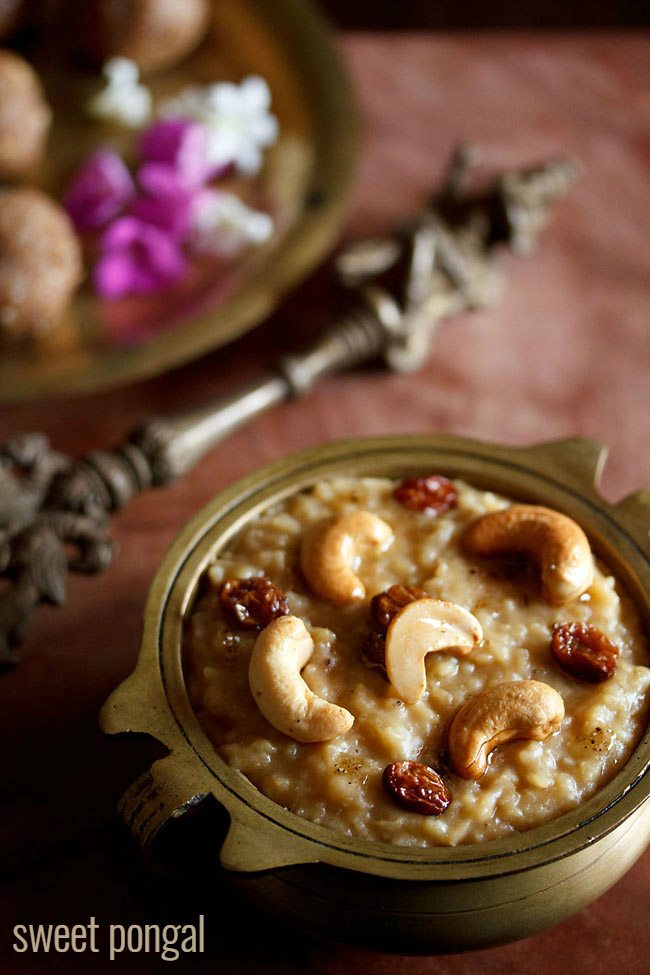
About Sweet Pongal
There are some South Indian recipes offered in temples that are a favorite with us – Ven Pongal, Curd Rice, Tamarind Rice, Paal Payasam and this sweet Pongal. I have had these recipes as prashad (naivdeyam) in many South Indian temples and loved their taste.
Sweet Pongal is made with cooked rice and yellow moong lentils to which jaggery is added. Jaggery is Indian unrefined cane sugar and has a molasses-like flavor and taste. So you can imagine what this sweet pongal tastes like.
The flavorings added in sakkarai pongal are of course green cardamom powder coupled with some cashews and raisins.
Table of Contents
During pooja or on auspicious days, I make sweets and offer them to the Mother Goddess. Whenever I offer anything to the deities, I always add a pinch of edible camphor in these delicacies.
Though do note that adding edible camphor in your sweet pongal is entirely optional.
I also add clove powder or clove to any savory or sweet dish that I offer to the Devi. This is something which I follow in our family, as my mother and mother-in-law do the same.
So in this chakkara pongal, I have powdered one clove and added it. Though adding clove is optional.
I make sweet pongal both in a stovetop pressure cooker and the Instant Pot. When making for more portions or servings, the Instant Pot is very helpful.
Here I share making pongal in a regular stovetop pressure cooker with stepwise photos and I also share the instant pot method below.
How to make Sweet Pongal
For your ease of understanding and reading, I have divided the entire step by step recipe of sweet pongal into 6 steps. So that it is easy for you.
- Roasting rice and moong dal
- Cooking rice & moong lentils
- Preparing jaggery syrup
- Sweetening rice and lentils
- Frying dry fruits
- Making sweet pongal
Roast Rice and Moong Lentils
1. Pick ½ cup rice and ⅓ cup moong dal first to get rid of stones if any. Then heat a small pan or a small kadai and add both the rice and moong lentils.
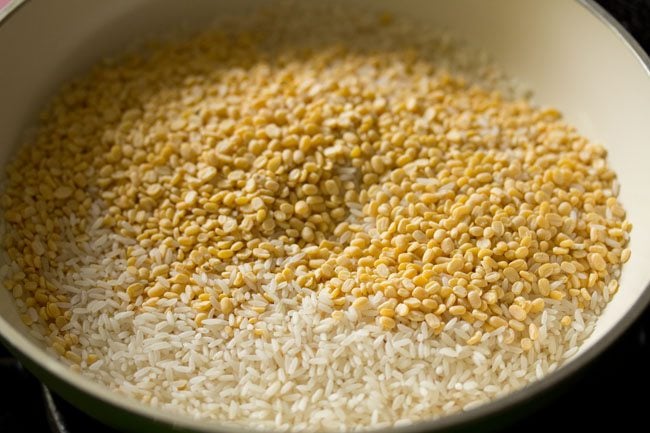
2. On a low heat stirring often roast both the rice and moong lentils, until they become aromatic.
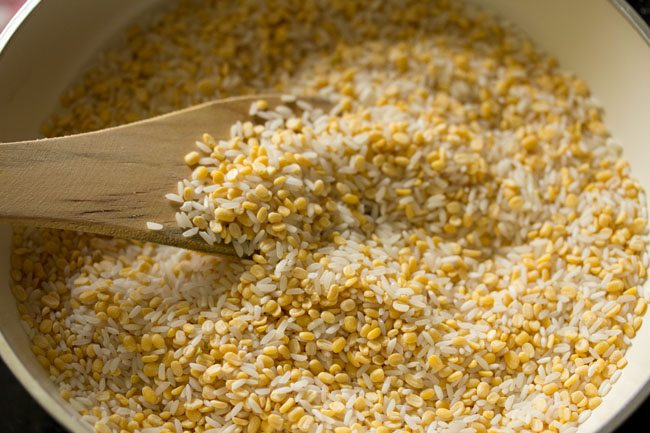
3. You only need to roast, until the moong lentils become aromatic. You do not require to brown them.
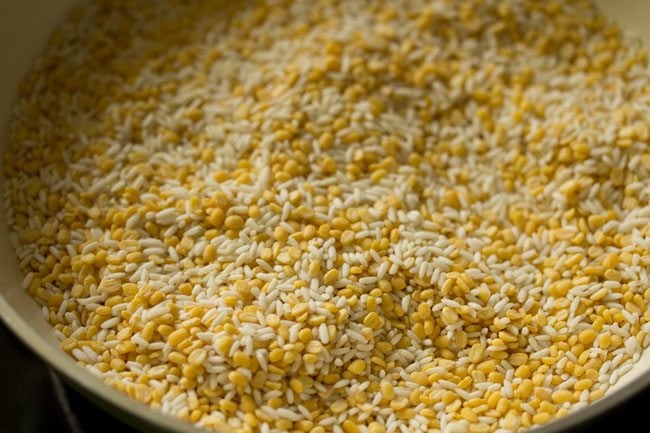
4. Now take the roasted rice and lentils in another bowl or a strainer.
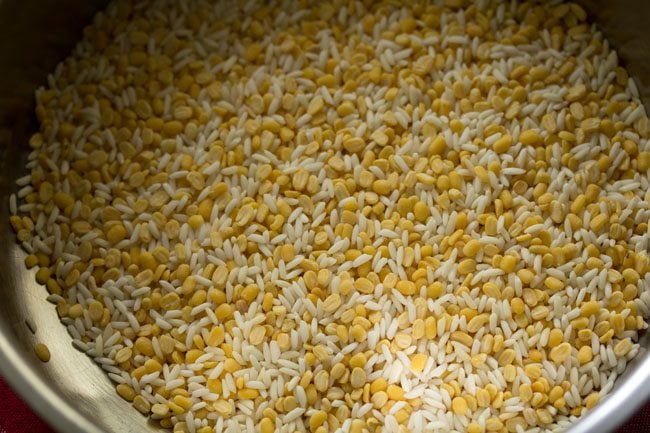
5. Rinse both the roasted rice and moong dal a couple of times with fresh clean water.
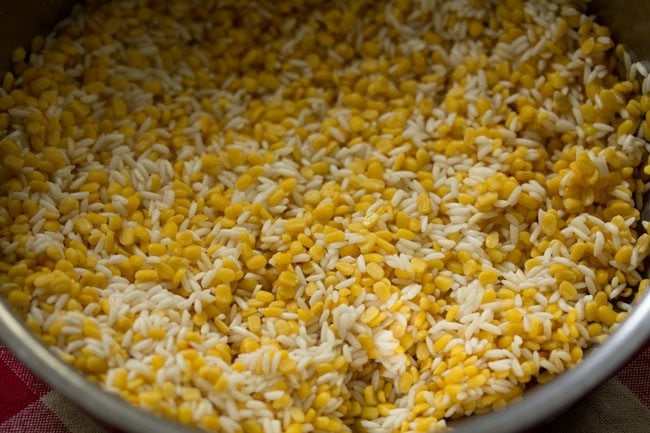
Cook Rice and Moong Lentils
6. Drain well and then add both rice and lentils in a 3 litre pressure cooker. Pour 3 cups water. The amount of water can add depends on the consistency you prefer and the quality of moong dal.
Mostly I cook the moong lentils for 8 to 9 whistles on medium heat. Thus I add 3 or 3.25 cups water.
For quicker cooking variety of moong lentils, add 2.5 cups water and pressure cook for 2 to 3 whistles on medium heat.
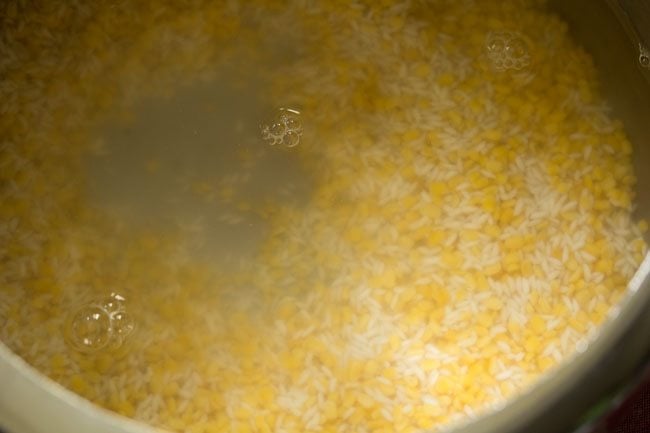
7. Pressure cook on medium heat for 11 to 12 minutes or for 8 to 9 whistles.
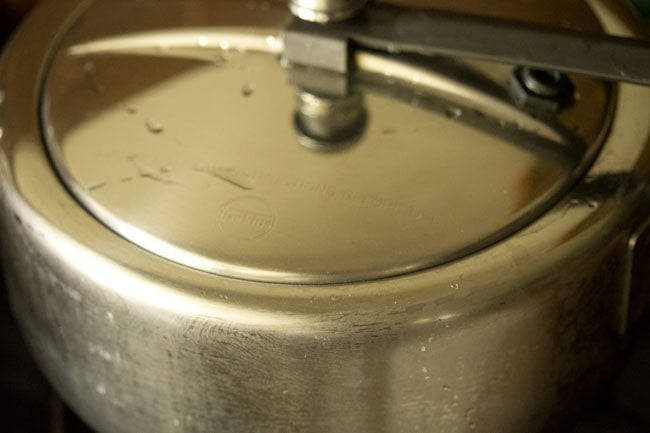
8. When the pressure settle down on its own in the cooker, then only remove the lid. Check to see if the rice and lentils have softened nicely and look mushy.
Tip: Add ½ to 1 cup hot water and mix thoroughly, if you get a separate texture of rice and lentils similar to that of a Pulao.
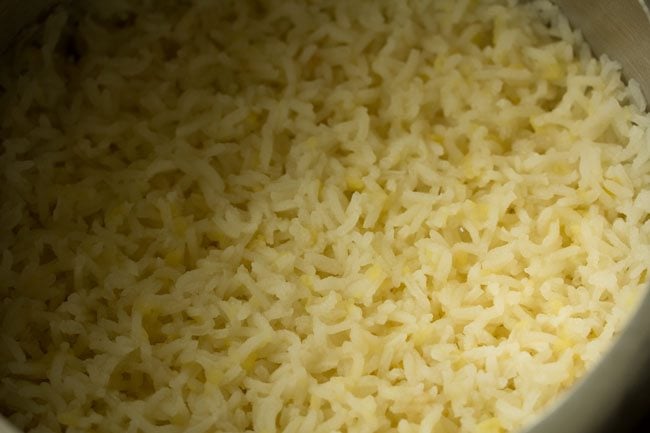
9. Both the rice and the moong dal should be cooked very well and mushy. With a spoon slightly mash the cooked rice and moong lentils.
If cooked well, then cover with the lid and set aside. The consistency of the cooked rice and lentils is like that of a Khichdi.
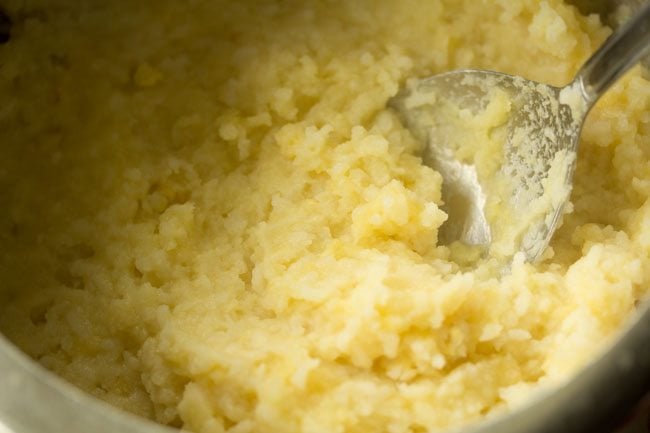
10. Meanwhile when the rice is cooking, crush seeds of 5 green cardamoms + 1 clove in a mortar-pestle.
If using green cardamom powder alone, then you can add ½ teaspoon of it.
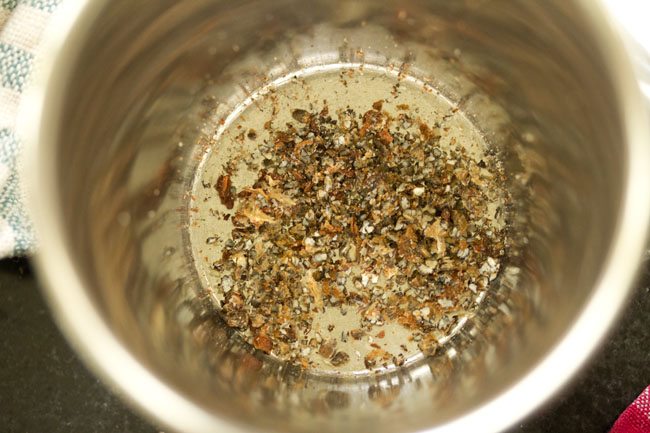
Prepare Jaggery Syrup
11. Chop 115 to 120 grams jaggery. You should get about ½ cup tightly packed chopped or grated jaggery.
This much amount of jaggery makes the sakkarai pongal just sweet. For more sweetness, you can add ¼ cup more.
On occasions I also use organic jaggery powder and add it directly to the cooked rice+moong lentils.
Tip: If you are using jaggery or jaggery powder without impurities, then you can add it directly to the cooked rice+lentils mixture.
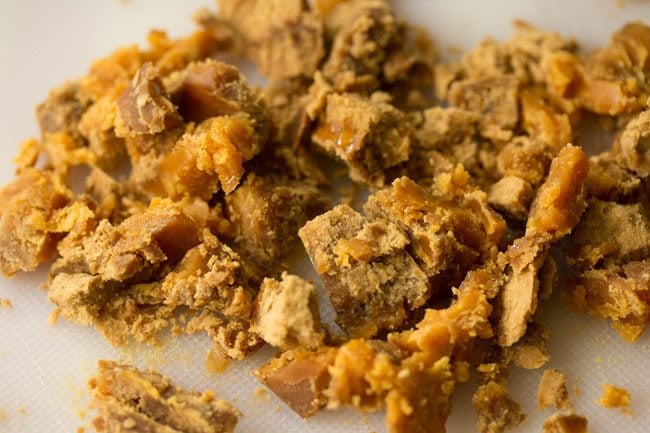
12. Now take ½ cup water in a pan. Add the chopped jaggery.
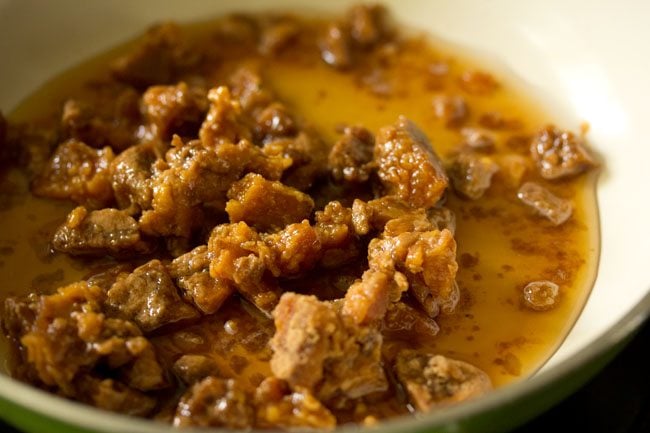
13. On a low to medium flame, heat this jaggery solution until the jaggery melts completely.
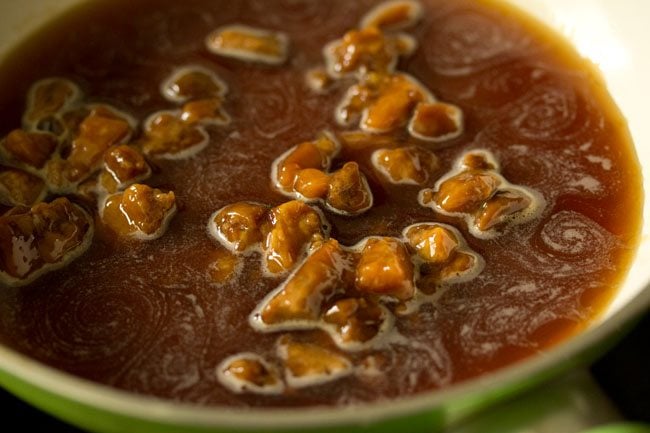
14. Do stir and break the jaggery chunks or pieces with a spatula or spoon so that they melt easily.
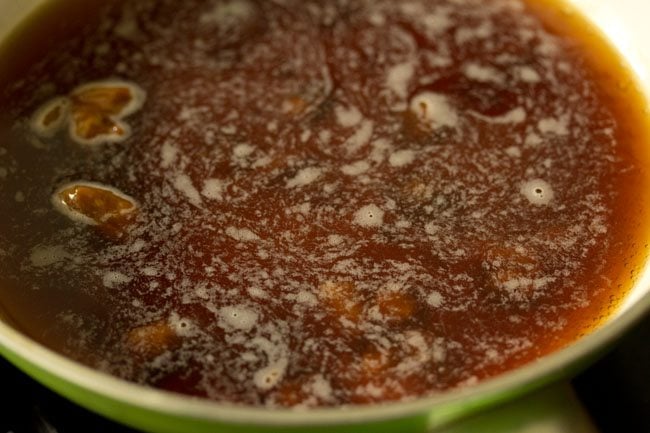
15. Let the syrup bubble up a bit. You will get an amber colored syrup when all the jaggery is melted, if you have used dark jaggery.
If you have light colored jaggery, then the color will be pale yellow to yellow. If you want you can thicken the syrup more.
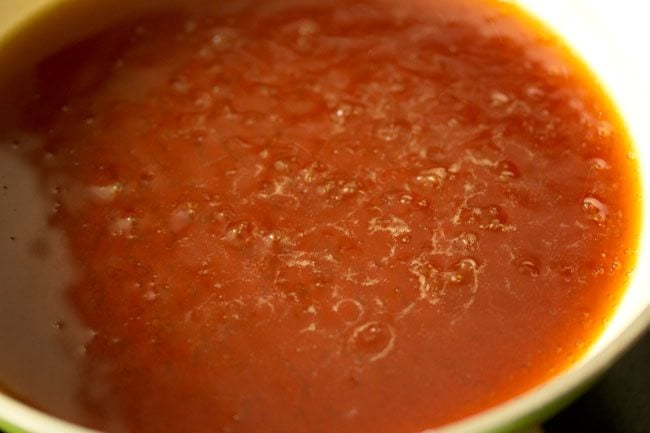
Sweeten Rice and Lentils
16. Straining the jaggery syrup through a fine mesh strainer or tea strainer, directly add it in the cooked rice+lentils mixture. If using organic jaggery powder, you can add it directly.
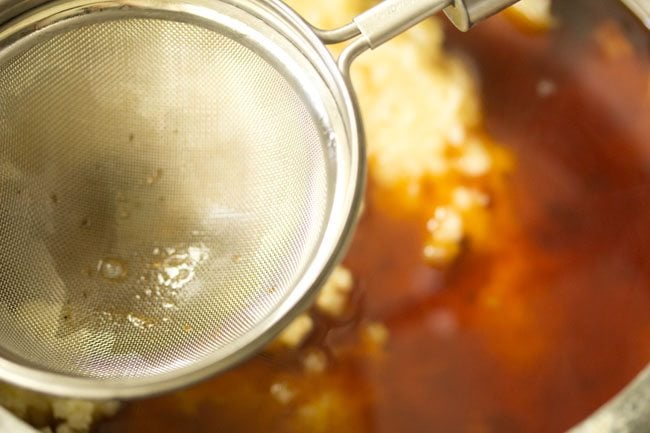
17. Now add the crushed cardamom and clove powder and a pinch of edible camphor (optional).
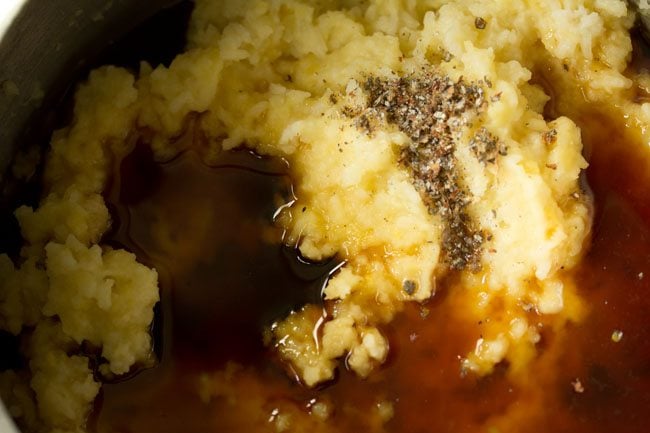
18. Mix everything very well. The chakkara pongal will thicken as it cools. So if the mixture looks thick, then you can add ¼ to ⅓ cup hot water.
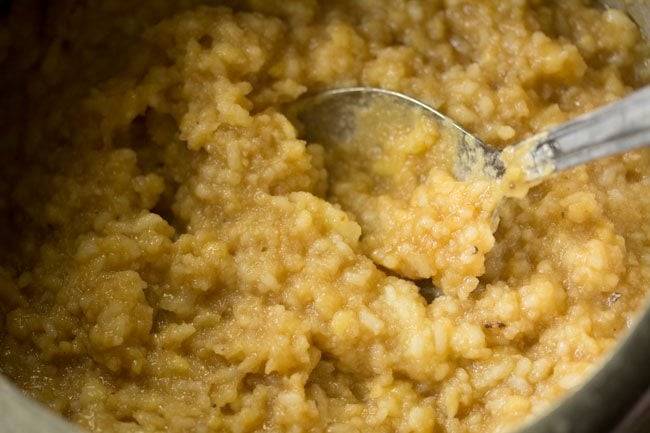
Fry Cashews and Raisins
19. Heat 4 to 5 tablespoons ghee. You can add a bit less ghee if you prefer.
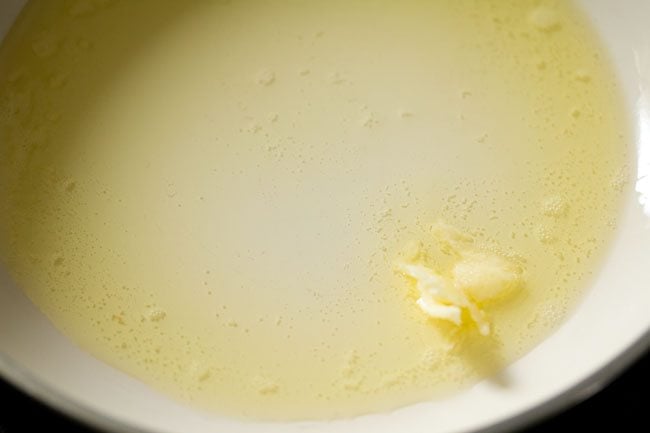
20. Add 12 to 15 cashews. You can keep the cashews whole or halve or chop them.
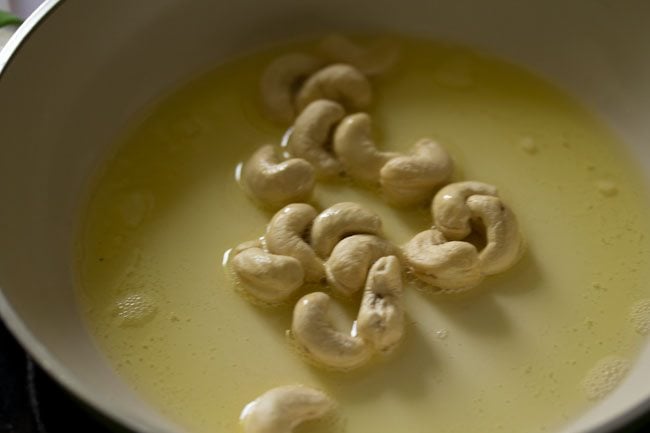
21. Fry the cashews until they become light golden.
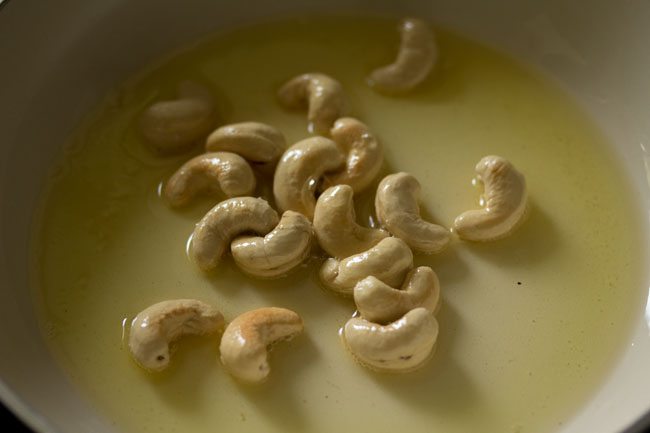
22. Then add 1 tablespoons raisins.
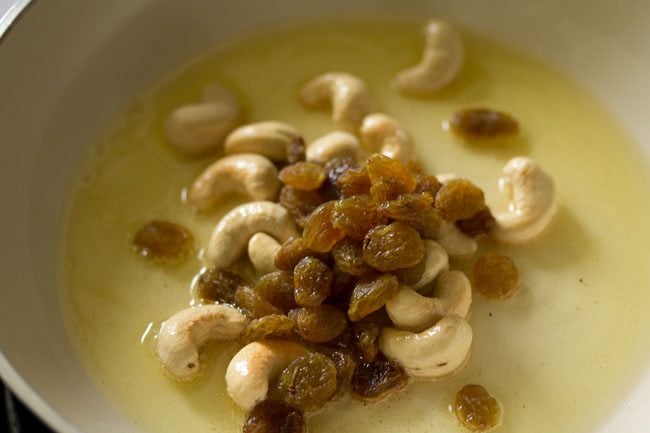
23. Begin to stir and fry.
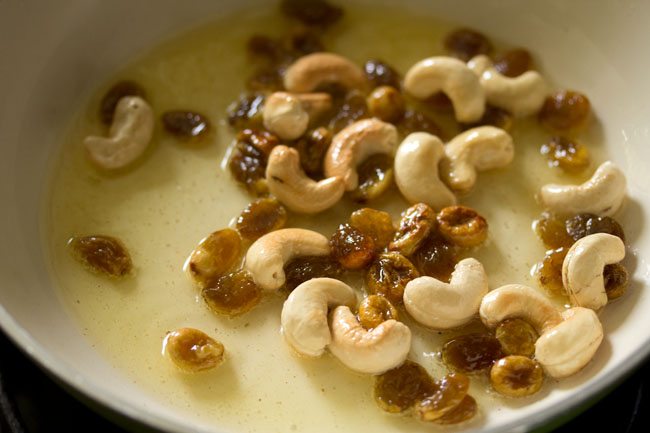
24. Stirring often fry until the raisins swell and become plump.
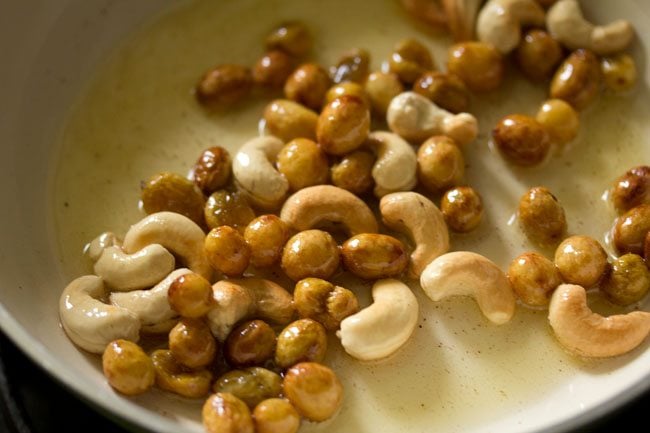
Make Sweet Pongal
25. Then immediately remove the pan from the stove top and add the fried cashews, raisins and ghee to the cooked rice and lentils.
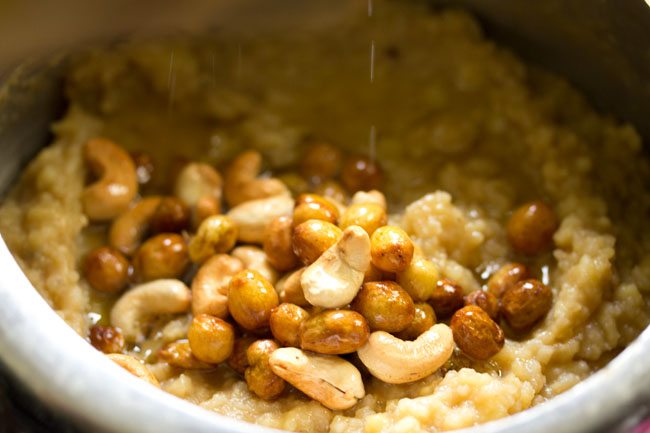
26. Mix very well.
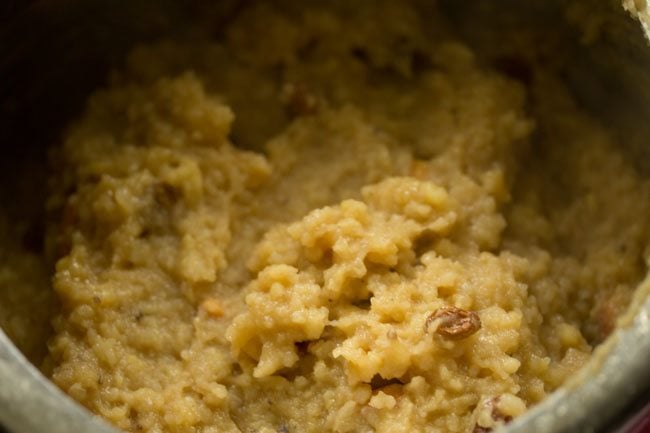
27. Offer to the Goddess or you can serve sweet pongal hot or warm to your family members.
You can garnish sakkarai pongal with some of the fried cashews and raisins while serving.
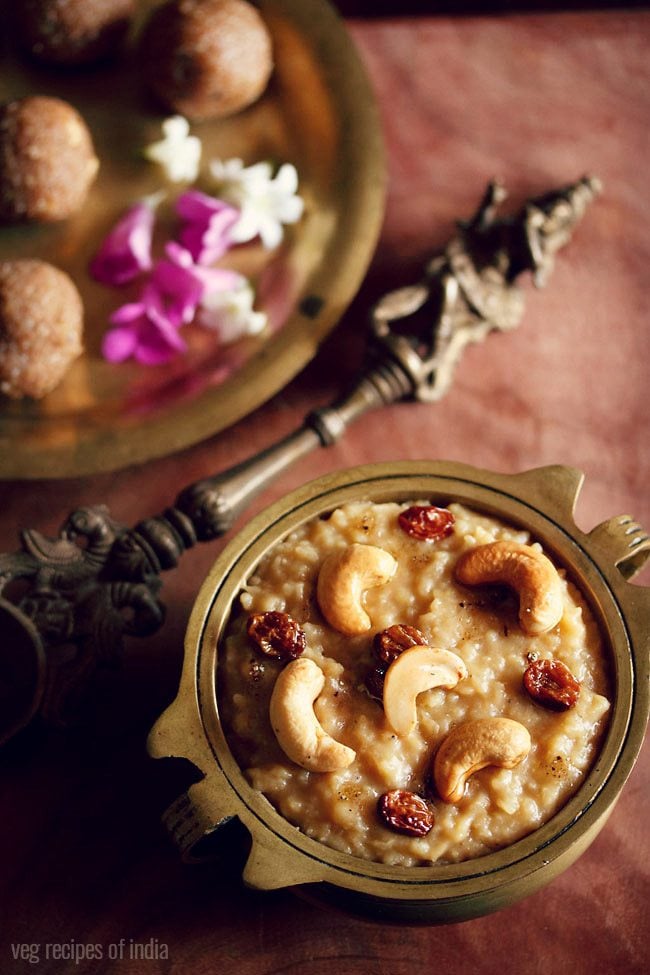
Variations
- With milk: Some version of sweet pongal are made with milk. So you can definitely add milk in place of water in this recipe. Milk will make the chakkara pongal slightly richer and creamier.
- With sugar: Though jaggery is traditionally used in making sakkarai pongal, but you can replace it with raw sugar or white sugar. Sweeteners like coconut sugar or palm sugar also make excellent substitutes.
- Healthy ingredients: Rice and moong lentils are again the norm in a sweet pongal. Though of course you can deviate and make sakkarai pongal with cracked wheat (dalia), millets or oats.
How to make Sweet Pongal in Instant Pot
Follow these steps to make sweet pongal in your IP:
- First roast the rice and lentils separately in a frying pan or a skillet. Then rinse both the rice and lentils a few times with water.
- Add the rinsed rise and lentils to the steel insert of a 6 quart Instant Pot.
- Pour 3.5 cups water. Pressure cook on high pressure for 6 to 7 minutes. Do a quick pressure release after 10 to 12 minutes.
- If you see that the consistency is thick or with separate grains, then pour some water. Mix and press the sauté button to simmer the mixture for a couple of minutes.
- Add the ground cardamom and clove powder. Make the jaggery syrup and add it. Later fry the cashews, raisins separately and mix it with the cooked rice and lentils. Serve Sweet Pongal hot or warm.
Expert Tips
Ingredient Notes
- Sweeteners: Jaggery imparts a lovely earthy molasses-like taste in sakkarai pongal. If you do not have jaggery, then add raw sugar or white sugar in the same amount. Palm sugar and coconut sugar also work wonderfully in a sweet pongal.
For more sweetness, you can add ¼ cup more jaggery. On occasions, I also use organic jaggery powder and add it directly to the cooked rice+moong lentils. Jaggery can be easily purchased online or on amazon. - Ghee: You can add a bit less ghee if you prefer that. More ghee will definitely make the chakkara pongal rich and more flavorful.
- Rice: Any medium or short-grained non-sticky rice can be used. Generally, during the pongal festival, freshly harvested rice is used. If you can get freshly harvested rice, then do make the sweet pongal recipe with it.
- Spices: Cardamom is an essential spice. But you can omit clove and edible camphor.
Recipe Notes
- Cooking lentils: Depending on the quality of moong dal you adjust the amount of water and pressure cook for less or more time. I pressure cook the lentils for 8 to 10 whistles and add 3 or 3.25 cups water. If your moong lentils cook faster, then add 2.5 cups water and pressure cook them for 2 to 3 whistles on medium heat.
- Cooking in a pan: You can easily make chakkara pongal on the stove-top in a pot or pan. Dry roast the rice and lentils first. Add them in a pan with 4 to 4.5 cups water and cook until softened. Do add more water if required.
- Proportion of rice and lentils: In my recipe, the proportion of rice is slightly more. Equal proportions of moong lentils and rice also work well.
- Scaling: You can easily double or triple this recipe of chakkara pongal to make a large batch.
- Storage: If you have any leftovers then store in the fridge for 1 to 2 days. I would not recommend freezing as the taste will not be the same and it is always better to eat rice and lentils freshly cooked. After refrigeration, if the consistency looks very thick or lumpy, then add some hot water or milk to thin it slightly.
More South Indian Sweets!
Sweets Recipes
South Indian Food
Sweets Recipes
Sweets Recipes
Please be sure to rate the recipe in the recipe card or leave a comment below if you have made it. For more vegetarian inspirations, Sign Up for my emails or follow me on Instagram, Youtube, Facebook, Pinterest or Twitter.
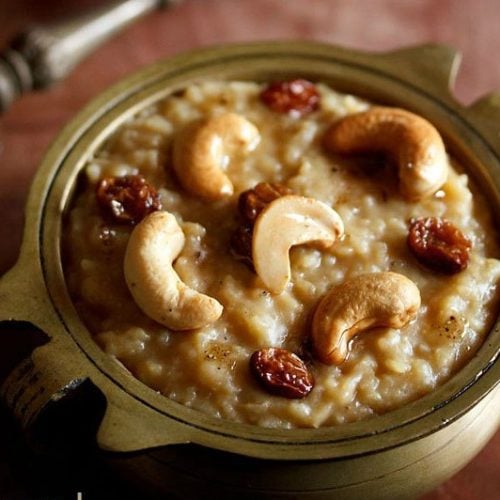
Sweet Pongal | Festive Sakkarai Pongal | Chakkara Pongal
Ingredients
Main ingredients
- ½ cup rice (any short to medium grained variety) – 100 grams
- ⅓ cup moong dal (husked and split mung lentils) – 85 grams, you can also add ¼ cup mung lentils
- 3 cups water – for pressure cooking
- ½ cup jaggery chopped and tightly packed – 115 to 120 grams or ½ cup tightly packed jaggery powder
- ½ cup water – for the jaggery syrup
- 1 pinch edible camphor – optional
- 5 green cardamoms or ½ teaspoon green cardamom powder
- 1 clove – optional
For frying
- 4 to 5 tablespoons Ghee (clarified butter)
- 15 to 18 cashews
- 1 tablespoon golden raisins
Instructions
Roasting rice and moong dal
- Pick the rice and moong dal first to get rid of stones if any. Then heat a small pan or a small kadai and add both the rice and moong lentils.
- On a low heat stirring often roast both the rice and moong lentils, till they become aromatic.
- You only need to roast till the moong lentils become aromatic. No need to brown them.
- Now take them in another bowl.
- Rinse both the roasted rice and moong dal a couple of times with water.
Cooking rice and moong lentils
- Drain well and then add them in a pressure cooker.
- Pour 3 cups water. The amount of water you can add depends on the consistency you prefer and on the quality of moong dal.
- Pressure cook on medium heat for 11 to 12 minutes or for 8 to 9 whistles.
- Let the pressure settle down on its own in the cooker. Then remove the lid to check the doneness and consistency of the rice and lentils. If you see a separate texture like that of a pulao/pilaf, then add ½ to 1 cup hot water and mix very well.
- Both the rice and the moong dal should be cooked very well and look mushy. With a spoon, slightly mash the cooked rice and moong lentils. If cooked well, then cover with the lid and keep aside. The consistency of the cooked rice and lentils is like a khichdi.
Preparing jaggery syrup
- Meanwhile when the rice is cooking, crush seeds of 5 green cardamoms + 1 clove in a mortar-pestle. If using cardamom powder alone, then you can add ½ teaspoon of it.
- Chop jaggery. You should get about ½ cup tightly packed, chopped or grated jaggery. This much amount of jaggery makes the pongal just sweet.
- Now take ½ cup water in a pan. Add the jaggery.
- On a low to medium flame, heat this jaggery solution until the jaggery melts completely.
- Do stir and break the jaggery chunks or pieces with a spatula so that they melt easily.
- You will get an amber colored syrup when all the jaggery is melted, if you have used dark jaggery. If you have light colored jaggery, then the color will be pale yellow to yellow.
Sweetening cooked rice and lentils
- Straining the jaggery syrup through a fine mesh strainer, directly add it in the cooked rice and lentils mixture. If using jaggery powder, you can add directly.
- Now add the crushed cardamom+clove powder and a pinch of edible camphor.
- Mix everything very well. Pongal will thicken as it cools. So if the mixture looks thick, then you can add ¼ to ⅓ cup hot water or hot milk.
Frying cashews and raisins
- Heat 5 tablespoons ghee. You can add less ghee if you want.
- Add the 12 to 15 cashews. Saute the cashews till they become light golden.
- Then add 1 tablespoons raisins. Begin to stir and fry.
- Stirring often fry until the raisins swell and become plump.
Making sweet pongal
- Then immediately remove the pan from the stovetop and add the fried cashews, raisins and ghee to the cooked rice and lentils.
- Mix thoroughly.
- Offer to the Goddess or you can serve sweet pongal hot or warm to your family members.
Notes
Variations
- With milk: Some versions of sweet pongal are made with milk. You can add milk in place of water in this recipe. Milk will make the sakkarai pongal slightly richer and creamier.
- With sugar: Though jaggery is traditionally used in making sakkarai pongal, you can replace it with raw sugar or white sugar, or rock sugar. Sweeteners like coconut sugar or palm sugar also make great substitutes.
- Healthy ingredients: Sweet pongal is always made with rice and moong lentils. But you can make it with cracked wheat (dalia), millets, or rolled oats.
Making Sweet Pongal in the Instant Pot
- Firstly, roast the rice and lentils separately in a frying pan or skillet. Rinse and add these to the steel insert of your IP.
- Pour 3.5 cups of water. Pressure cook on high pressure for 6 to 7 minutes. Do a quick pressure release after 10 to 12 minutes.
- If you see that the consistency is thick or with separate grains, then pour some water. Mix and press the sauté button to simmer the rice and lentil mixture for a couple of minutes.
- Add the ground cardamom and clove powder. Make the jaggery syrup and add it. Later fry the cashews, raisins separately and mix it with the cooked rice and lentils. Serve hot or warm.
Ingredient notes
- Sweeteners: Jaggery imparts a lovely earthy molasses-like taste. If you do not have jaggery, then add raw sugar or white sugar in the same amount. Palm sugar and coconut sugar also work wonderfully in a sweet pongal. For more sweetness, you can add ¼ cup more jaggery. On occasions, I also use organic jaggery powder and add it directly to the cooked rice+moong lentils. Jaggery can be easily purchased online or on amazon.
- Rice: Any medium or short-grained non-sticky rice can be used. Generally, during the pongal festival, freshly harvested rice is used. If you can get freshly harvested rice, then do use it to make sweet pongal.
- Ghee: You can add a bit less ghee if you prefer that. More ghee will definitely make the chakkara pongal rich and more flavorful.
- Spices: Cardamom is an essential spice. But you can omit clove and edible camphor.
Recipe notes
- Cooking lentils: Depending on the quality of moong dal you can adjust the amount of water and pressure cook for less or more time. I pressure cook the lentils for 8 to 10 whistles and add 3 or 3.25 cups water. If your moong lentils cook faster, then add 2.5 cups water and pressure cook them for 2 to 3 whistles on medium heat.
- Cooking in a pan: You can easily make sweet pongal on the stove-top in a pot or pan. Dry roast the rice and lentils first. Add them to a pan with 4 to 4.5 cups water and cook until softened. Do add more water if needed.
- Proportion of rice and lentils: In my recipe, the proportion of rice is slightly more. Equal proportions of moong lentils and rice also work well.
- Scaling: You can easily double or triple this recipe of chakkara pongal to make a large batch.
- Storage: If you have any leftovers then store them in the fridge for 1 to 2 days. I would not recommend freezing as the taste will not be the same and it is always better to eat rice and lentils freshly cooked. After refrigeration, if the consistency looks very thick or lumpy, then add some hot water or milk to thin it slightly.
Nutrition Info (Approximate Values)
This Sweet Pongal recipe from the archives was first published in July 2016. It has been updated and republished on January 2023.
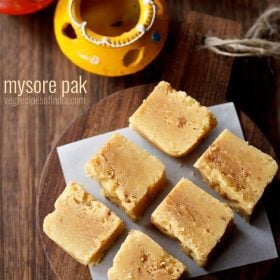
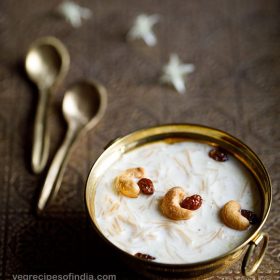
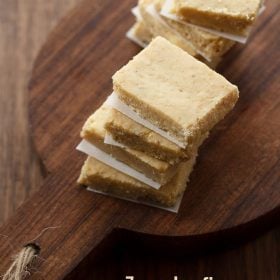
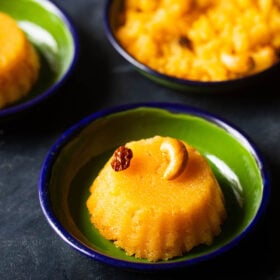








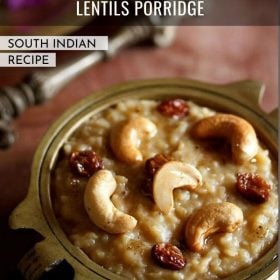
I just love this so much mmm !
Perfect Recipe. I prepared it and everyone liked it.
Happy to hear! Thanks for the feedback and the rating.
I have tried this recipe twice and it was a hit both times. I serve it with chana dal as that balances the sweetness. Thank you for this perfect recipe!
Thank you for sharing this feedback on the recipe. Glad to know. Most welcome.
Hi
I have prepared sakkarai pongal. The consistency, texture, smoothness is perfect. But the sweetness is too much, as every jaggery ball differs in sweetness.
What can be done to reduce the sweetness. Pls give me a suggestion.
Thanks
yes, the sweetness is more or less in types of jaggery. you can just add some warm water or warm milk in the pongal and the sweetness will reduce. hope this helps.